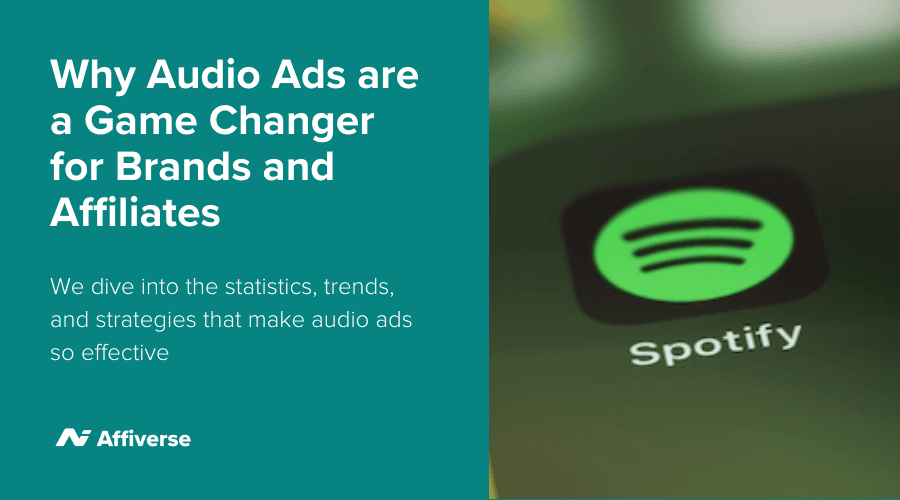Why Audio Ads are a Game Changer for Brands and Affiliates

When it comes to advertising in the digital universe, brands are constantly seeking new, innovative ways to engage with their target audiences.
Audio advertising has emerged as one of the most powerful tools in a marketer’s arsenal, with platforms like Spotify and podcasts playing a crucial role in this transformation. But what exactly makes audio ads so useful, and why should brands—and particularly affiliates—care?
Let’s dive into the statistics, trends, and strategies that make audio ads so effective.
The Power of Audio: Connecting with Audiences in Real Time
Audio advertising, unlike traditional digital ads, offers brands the ability to connect with consumers in a unique, intimate way. Unlike visual media, audio is consumed passively, allowing listeners to engage with content while multitasking.
Whether they’re driving, exercising, or working, listeners are more likely to absorb the messages conveyed through audio. The average podcast listener, for instance, consumes around 8 podcasts per week, indicating a significant engagement opportunity for advertisers.
Platforms like Spotify have become major drivers of audio advertising’s success. According to a recent report from Spotify, audio ads are not just engaging but are also highly effective at driving performance. They found that 41% of listeners take action after hearing an ad, a huge figure compared to other forms of advertising.
These actions include visiting a brand’s website, following up on promotions, or making a purchase.
One reason for this is the personalized nature of audio content. With access to data such as listening habits and preferences, platforms can tailor ads to fit the individual listener’s tastes, increasing the chances of engagement.
In the world of performance marketing, this is key, as it ensures ads reach the right people at the right time, thus improving conversion rates.
Stats That Prove Audio Ads Work
Several statistics highlight the growing dominance of audio ads in the marketing ecosystem:
- Increased brand recall: Research shows that audio ads, particularly in the podcasting space, have a 24% higher brand recall rate than traditional display ads.
- Higher engagement: A study by Nielsen found that audio ads are 2.5 times more likely to engage audiences than traditional banner ads, largely due to their ability to be consumed during other activities.
- Cost efficiency: Audio ads tend to be more cost-effective than video or display ads, especially on platforms like Spotify, where advertisers can reach niche audiences without the heavy production costs associated with video.
- Personalised experience: Platforms like Spotify leverage their vast amount of user data to target ads that are more relevant to listeners. This tailored approach can improve both engagement and conversion rates, making audio a powerful tool for performance marketers.
Why Audio Ads are Critical for Affiliates
Affiliates play a crucial role in the marketing ecosystem, particularly when it comes to driving sales and conversions. For affiliates, audio ads represent a huge opportunity to diversify their promotional strategies and reach audiences in ways that traditional ads can’t.
Here’s why audio ads should be an important part of any affiliate’s toolkit:
- High Conversion Potential: As mentioned earlier, Spotify’s research shows that 41% of listeners take action after hearing an ad. For affiliates, this means increased potential for clicks and conversions, as listeners are more likely to engage with offers delivered through audio.
- Cost-Effective for High Returns: Affiliates often operate on tight budgets, making cost efficiency crucial. Audio ads, particularly those on streaming platforms or podcasts, provide a cost-effective way to reach a highly engaged audience without the high production costs of visual or video content.
- Growing Audience Base: The number of podcast listeners and streaming audio users continues to grow year after year. As more people turn to audio platforms for entertainment and information, affiliates have a massive opportunity to tap into these expanding markets.
- Authentic Sponsorship Opportunities: Audio ads often feel more authentic because they are embedded in content that the listener has chosen to consume. For example, podcast hosts frequently deliver ads themselves, creating a sense of trust and credibility that banner ads or pop-ups often lack. Affiliates can take advantage of this by partnering with influencers and podcasters, ensuring that their ads are not only heard but trusted.
- Cross-Promotion Synergy: Affiliates can also benefit from combining audio advertising with other marketing efforts. For example, audio ads can be used to support SEO campaigns by promoting specific content or offers, driving traffic from multiple sources. This type of synergy can help increase overall conversions and revenue.
Final Thoughts: Seizing the Opportunity
Audio advertising is no longer just a trendy marketing tactic—it’s a key player in the future of performance marketing. For brands, leveraging platforms like Spotify allows them to reach a growing, engaged audience with personalised, effective messaging.
For affiliates, audio ads provide a unique way to boost conversions while maintaining cost-efficiency.
As the world of digital marketing continues to evolve, staying ahead of the curve means recognizing and embracing new mediums like audio.
With high engagement rates, personalised targeting, and a rapidly growing listener base, there’s no better time to start investing in audio advertising, particularly for affiliates looking to drive performance and maximise their earnings.






